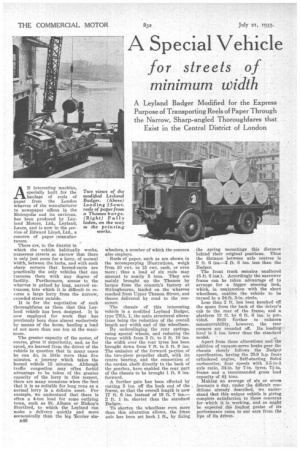A Special Vehicle
Page 60

If you've noticed an error in this article please click here to report it so we can fix it.
for streets of
minimum width
A Leyland Badger Modified for the Express Purpose of Transporting Reels of Paper Through the Narrow, Sharp-angled Thoroughfares that Exist in the Central District of London
AN interesting machine, specially built for the haulage of reels of paper from the London wharves of the manufacturer to newspaper offices in the Metropolis and its environs, has been produced by Leyland Motors, Ltd., Leyland, Lanes, and is now in the service of Edward Lloyd, Ltd., a concern of paper /manufacturers.
There are, in the district in which the vehicle habitually works, numerous streets so narrow that there is only just room for a lorry, of normal width, between the kerbs, and with such sharp corners that horsed-carts are practically the only vehicles that can traverse them with any degree of facility. Furthermore, access to the wharves is gained by long, narrow entrances, into which it is difficult to reverse a large lorry from the narrow, crowded street outside.
It is for the negotiation of such thoroughfares as these that this Leyland vehicle has been designed. It is now employed for work that has previously been done almost exclusively by means of the horse, hauling a load of not more than one ton at the maximum.
The greater capacity of the motor, of course, gives it superiority, and, as for speed, we learned from the driver of the vehicle in question that in many cases he can do, in little more than five minutes, a journey which takes the horsed vehicle 15 minutes. Although traffic congestion may often forbid advantage to be taken of the greater capacity of the lorry in this respect, there are many occasions when the fact that it is as suitable for long runs as a normal lorry is a definite asset. For example, we understand that there is often a 4-ton load for some outlying town, such as St. Albans or Bishop's Stortford, to which the Leyland can make a delivery quickly and more economically than the big Terrier six
n46 wheelers, a number of which the concern also employs.
Reels of paper, such as are shown in the accompanying illustrations, weigh from 10 cwt. to 15 cwt. each, or even more ; thus a load of six reels may amount to nearly 5 tons. They are mainly brought up the Thames by barges from the concern's factory at Sittingbourne, landed on the wharves reached from Upper Thames Street, and thence delivered by road to the consumer.
The chassis of this interesting vehicle is a modified Leyland Badger, type TSA, 1, the main structural alterations being the reduction of the overall length and width and of the wheelbase.
By underslinging the rear springs, using special wheels, and reducing the frame width from 3 ft. to 2 ft. 10 ins. the width over the rear tyres has been brought down from 7 ft. to 5 ft. 9 ins. The omission of the forward portion of the two-piece propeller shaft, with its centre bearing, and the connection of the cardan shaft directly to the back of the gearbox, have enabled the rear part of the chassis to be brought 1 ft. 8 ins. forward.
A further gain has been effected by cutting 5 ins, off the back end of the frame, so that the overall length is now 17 ft. 6 ins, instead of 19 ft. 7 ins.2 ft. 1 in, shorter than the standard Badger.
To shorten the wheelbase even more than this alteration allows, the front axle has been set hack 1 ft., by fixing the spring mountings this distance behind their original positions. Thus the distance between axle centres is 9 ft. 6 ins,-2 ft. 8 ins, less than the Badger.
The front track remains unaltered (5 ft. 6 ins.). Accordingly the narrower frame can be taken advantage of to arrange for a bigger steering lock, which, in conjunction with the short wheelbase, enables the vehicle to be turned in a 34-ft. 3-in. circle.
Less than 2 ft. has been knocked off the space from the back of the driver's cab to the rear of the frame, and a platform 13 ft. by 6 ft. 6 ins, is pro, vided. Still further to enhance manceuvrability, however, the rear corners are rounded off. Its loading level is 3 ins, lower than the standard model.
Apart from these alterations and the addition of vacuum-servo brake gear the chassis closely follows the Badger specification, having the 28.9 h.p. fours cylindered engine, Self-starting SoleX carburetter, four speeds with 5.5-to-1 axle ratio, 34-in. by 7-in. tyres, 7i-in. frame and a recommended gross load capacity of 4i tons. Making an average of six or seven journeys a day, under the difficult cons ditions already described, we understand that this unique vehicle is giving complete satisfaction to those concerns for which it is working, and as might be expected the loudest praise of its performance came to our ears from the lips of its driver.




























































































